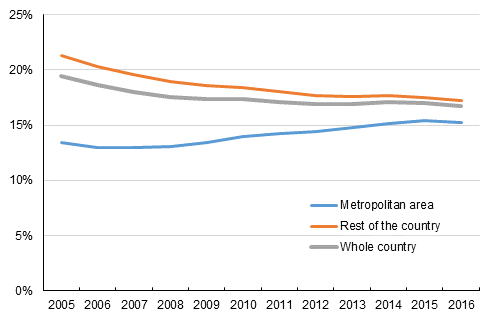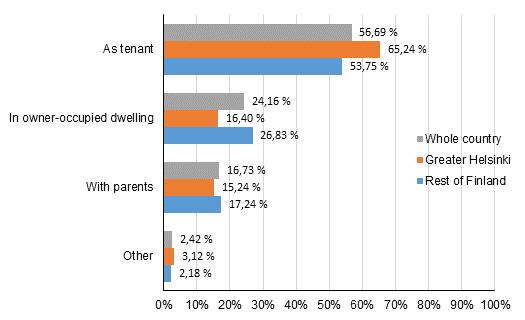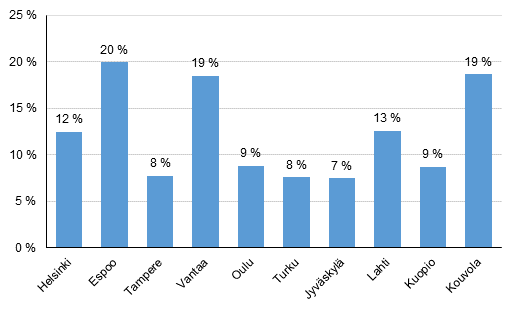Published: 11 October 2017
Ever fewer young people live with their parents in 2016
According to Statistics Finland, ever fewer young people aged 20 to 29 are living with their parents. At the end of 2016, slightly under 17 per cent of the dwelling population aged 20 to 29 were living with their parents. The most popular mode of housing among young people is rental living. Owner-occupied dwellings are usually acquired closer to the age of thirty.
Persons aged 20 to 29 living with their parents in 2005 to 2016

In 2016, around 17 per cent of Finland’s dwelling population aged 20 to 29 were living with their parents. This corresponds to some 111,000 persons while the entire dwelling population aged 20 to 29 amounted to around 663,000 persons in 2016. For the whole country, the share of young adults living with their parents has decreased by three percentage points in good ten years. In 2005, every fifth young adult lived with their parents. The dwelling population refers to people living in actual dwellings, that is, at home, at the end of the year. Persons living in institutions, in dormitories and abroad, as well as homeless people are not included in the dwelling population.
Small growth in the number of first-time homebuyers in Greater Helsinki in 2016
Unlike elsewhere in Finland, the share of persons aged 20 to 29 living with their parents has increased in Greater Helsinki over the past decade or so. In 2005, the share of young adults living with their parents of the dwelling population of the same age in Greater Helsinki was 13 per cent, and at the end of 2016 it was 15 per cent. Thus, the share of those living with their parents in Greater Helsinki has grown closer to the average for the whole country, even though young people in Greater Helsinki still live with their parents slightly less frequently than young people elsewhere in Finland. Greater Helsinki refers to a whole comprising Helsinki, Espoo, Vantaa and Kauniainen.
The most popular mode of housing among those aged 20 to 29 is rental living: nearly 57 per cent of the age group lived in rented dwellings at the end of 2016. Twenty-four per cent of young adults lived in owner-occupied dwellings and 17 per cent lived with their parents. In addition, around two per cent of young adults lived in dwellings with unknown tenure status, for example, based on kinship.
Housing based on tenure status: 20 to 29 year old in 2016

In Greater Helsinki, young people aged 20 to 29 live in rented dwellings more often than others and clearly more rarely in owner-occupied dwellings. These differences are also reflected in the average age of first-time homebuyers.
In 2016, the average age of first-time homebuyers was around 29. Regional differences were considerable. In Greater Helsinki, the average first-time homebuyer was thirty, which was two years older than elsewhere in Finland. The average age is calculated based on the persons having bought their first dwelling in a housing company in 2016.
Average age of first-time homebuyers in 2016
| Region | Persons | Average age |
| Whole country | 20,944 | 28.5 |
| Greater Helsinki region | 7,840 | 29.7 |
| Rest of Finland | 13,104 | 27.7 |
Considerable differences between ten largest municipalities
Despite the national shares of young people living with their parents having grown closer to one another, for example, in Greater Helsinki and elsewhere in the country, there are still regional differences in the housing behaviour of young adults. Next, we will examine the ten largest Finnish municipalities measured by the dwelling population.
The figure shows the share of those aged 20 to 29 living with their parents compared to the dwelling population of the same age. The municipalities are arranged in the order of size according to the population. The figure shows that in typical student cities like Jyväskylä, Turku and Tampere the share of young adults living with their parents is lower than in other municipalities. In addition, you can see that the municipalities in Greater Helsinki differ from one another. In Helsinki, 12 per cent of the dwelling population aged 20 to 29 are living with their parents, while the corresponding share is 20 per cent in Espoo and 19 per cent in Vantaa.
Those aged 20 to 29 living with their parents in 2016 ( 10 largest municipalities)

The ten largest municipalities differ from one another also based on the average age of first-time homebuyers. The first-time homebuyer in Helsinki is, on average, 30 years old. The youngest first-time homebuyers are found in Kouvola. There, the first home was bought at the average age of 27, i.e. three years younger than in Helsinki.
Average age of first time homebuyers in 2016
| Region | Persons | Average age |
| Helsinki | 4,509 | 30.0 |
| Espoo | 1,762 | 29.9 |
| Tampere | 1,652 | 28.4 |
| Vantaa | 1,528 | 28.8 |
| Turku | 1,115 | 28.4 |
| Oulu | 1,052 | 28.2 |
| Jyväskylä | 723 | 28.1 |
| Kuopio | 567 | 28.1 |
| Lahti | 495 | 27.8 |
| Kouvola | 146 | 27.2 |
Source: Dwellings and Housing Conditions, Statistics Finland
Inquiries: Otto Kannisto 029 551 3044, Marja Hermiö 029 551 3211, info@stat.fi
Director in charge: Jari Tarkoma
Publication in pdf-format (383.8 kB)
- Reviews
-
- 1. Dwelling stock 2016 (11.10.2017)
- 2. Household-dwelling units and housing conditions 2016 (11.10.2017)
- Tables
-
Tables in databases
Pick the data you need into tables, view the data as graphs, or download the data for your use.
Appendix tables
- Appendix table 1. Household-dwelling units by number of persons in 1960 - 2016 (11.10.2017)
- Appendix table 2. Household-dwelling units by housing density on 31 Dec. 2016, by region (11.10.2017)
- Appendix table 3. Household-dwelling units and persons by tenure status in 1970 - 2016 (11.10.2017)
- Appendix table 4. Average floor area (m2) of dwellings in the dwelling stock in 1970 - 2016 (11.10.2017)
- Appendix table 5. Dwelling stock and amenities in 1960 - 2016 (11.10.2017)
- Appendix table 6. 20 - 29-year-old residential population by family status, tenure and region 2005 - 2016 (11.10.2017)
- Appendix table 7. First-time homebuyers in 2006 to 2016 (11.10.2017)
Updated 11.10.2017
Official Statistics of Finland (OSF):
Dwellings and housing conditions [e-publication].
ISSN=1798-6761. Overview 2016. Helsinki: Statistics Finland [referred: 14.12.2025].
Access method: http://stat.fi/til/asas/2016/01/asas_2016_01_2017-10-11_tie_002_en.html

